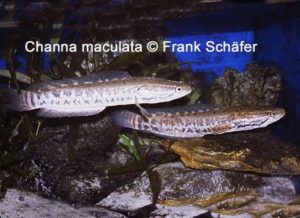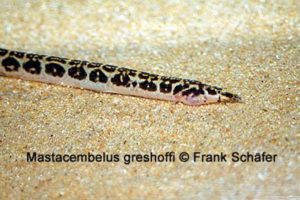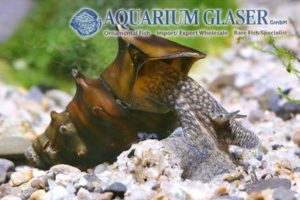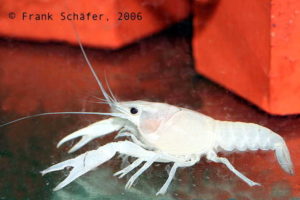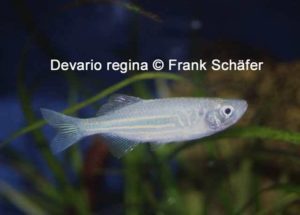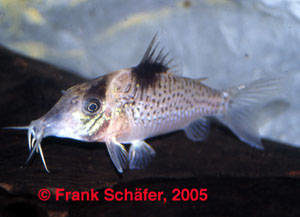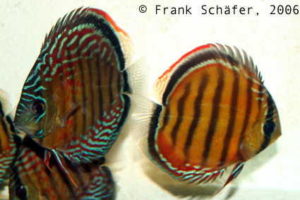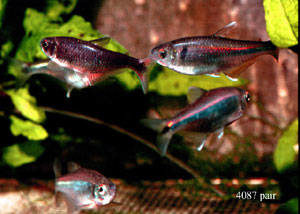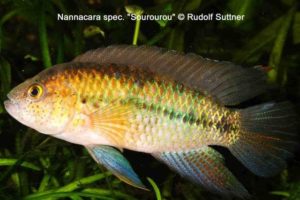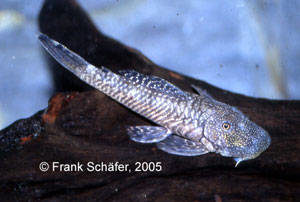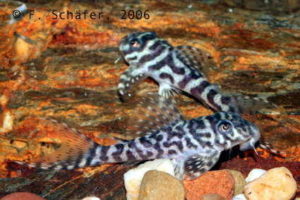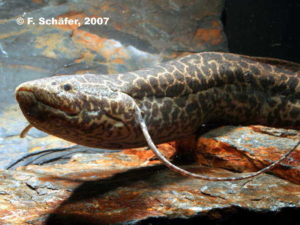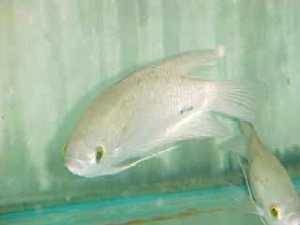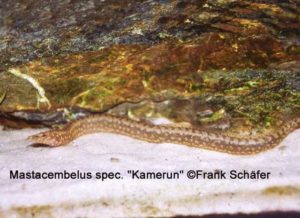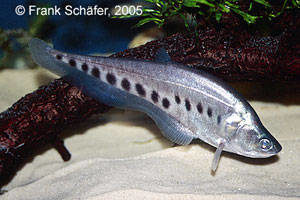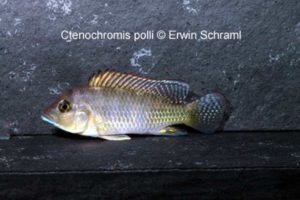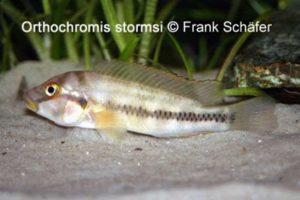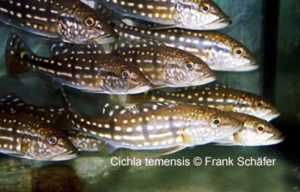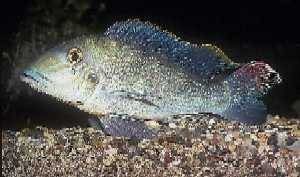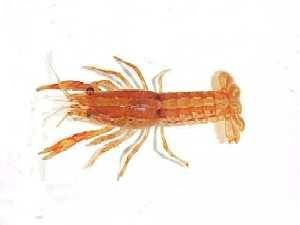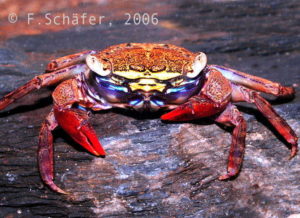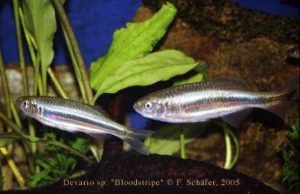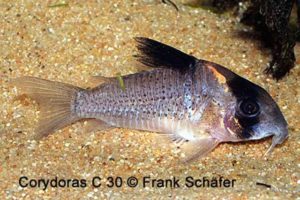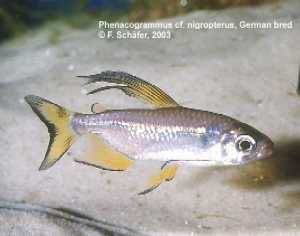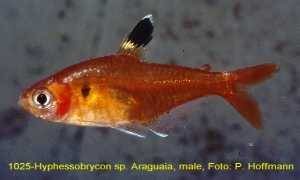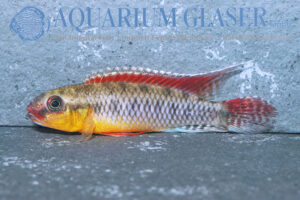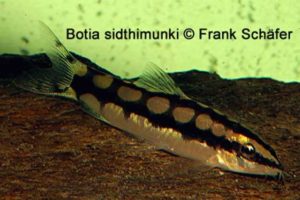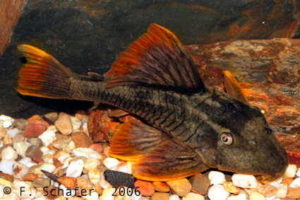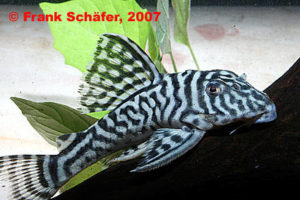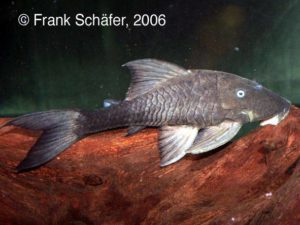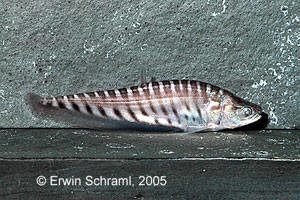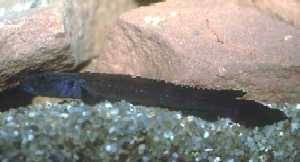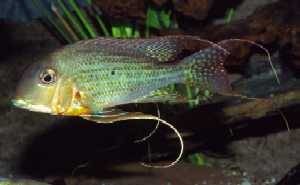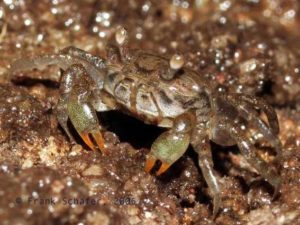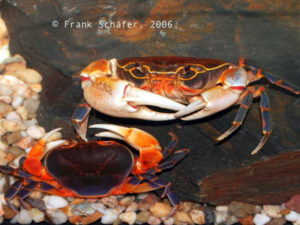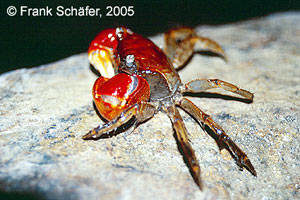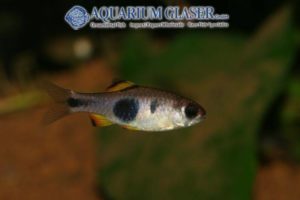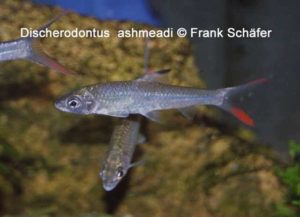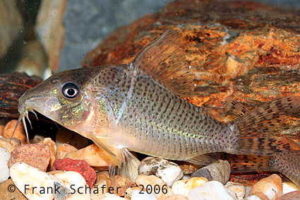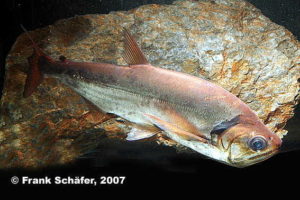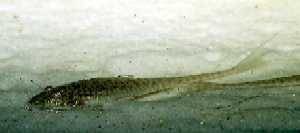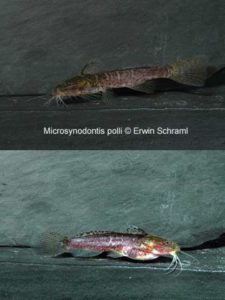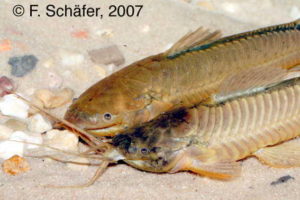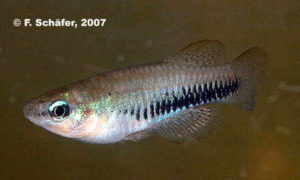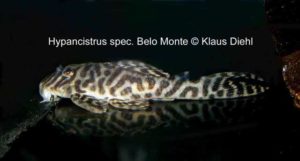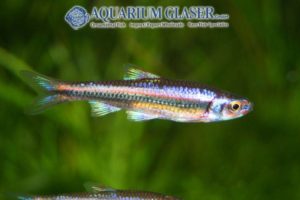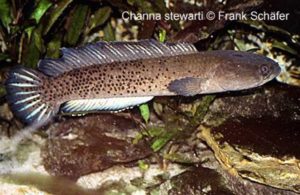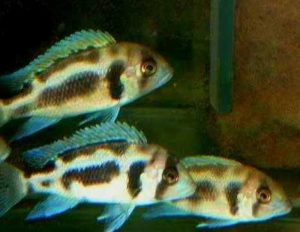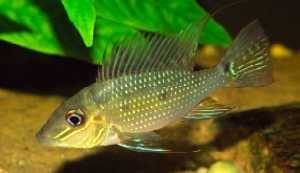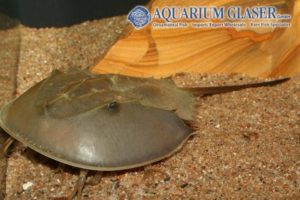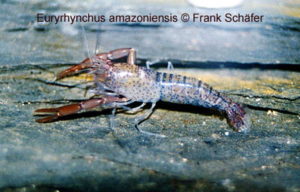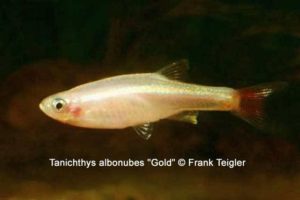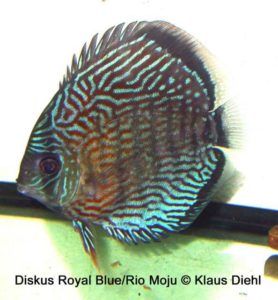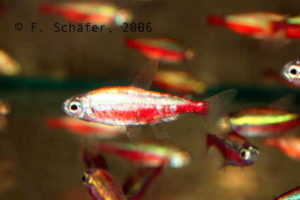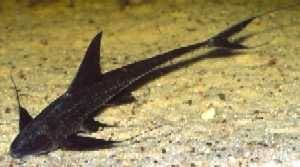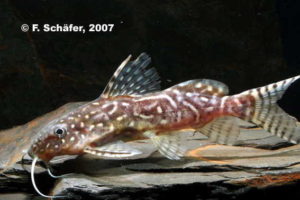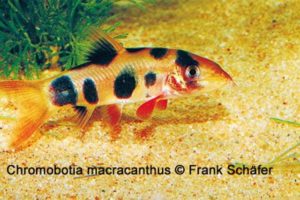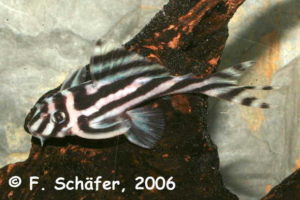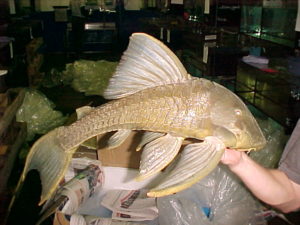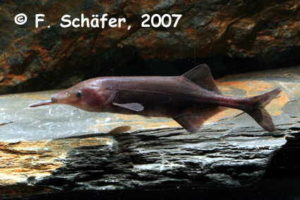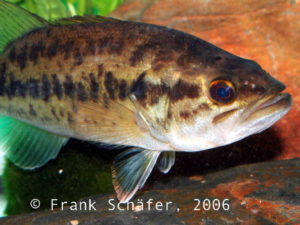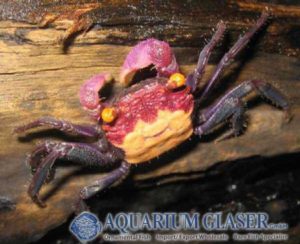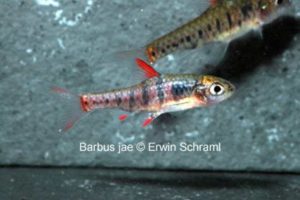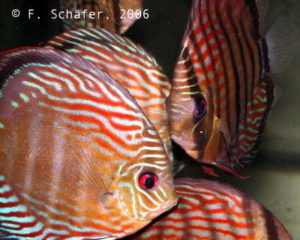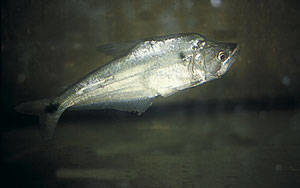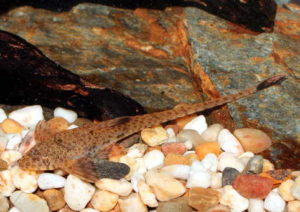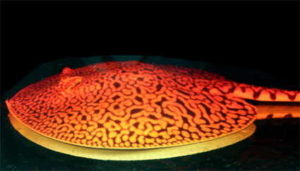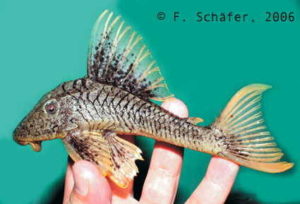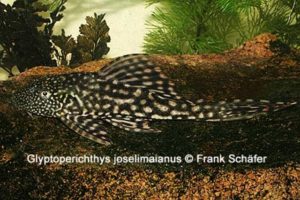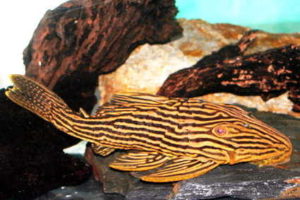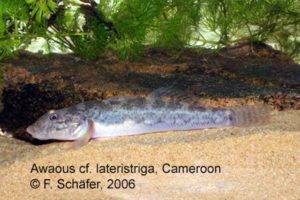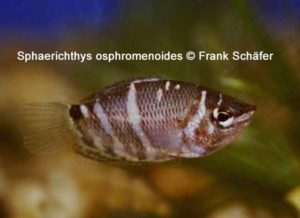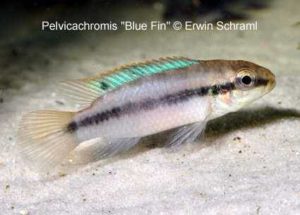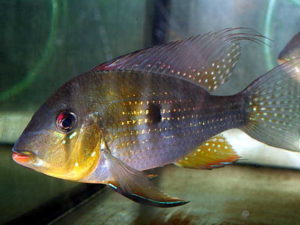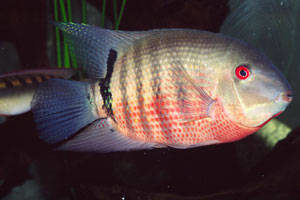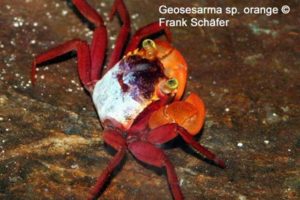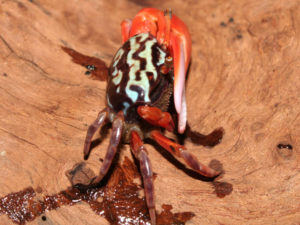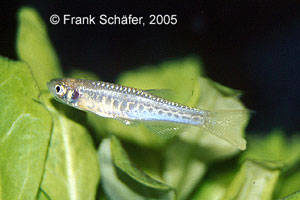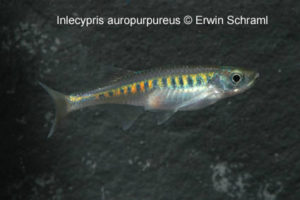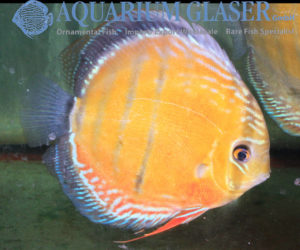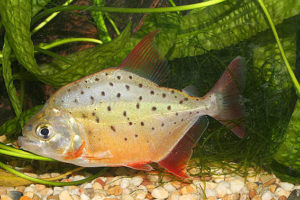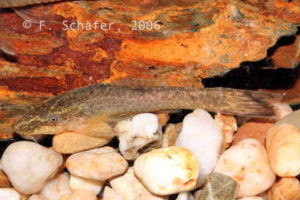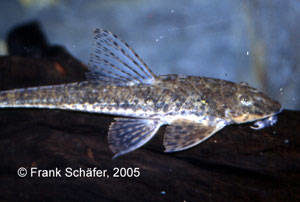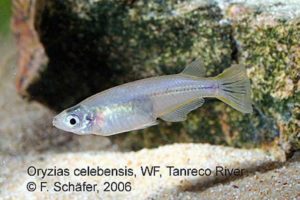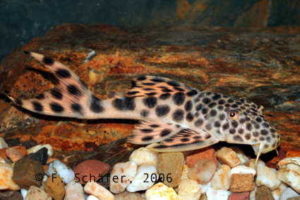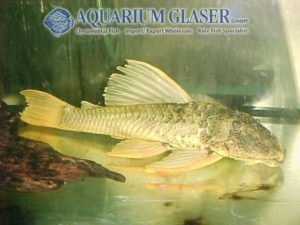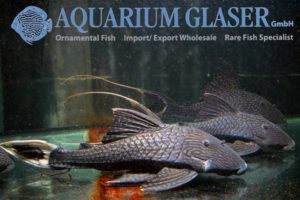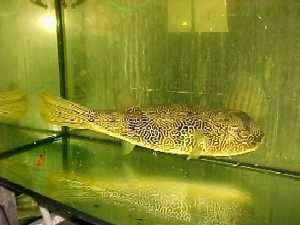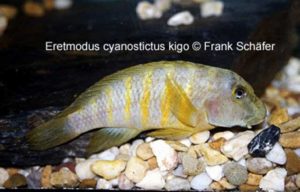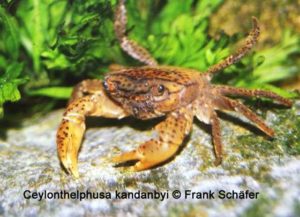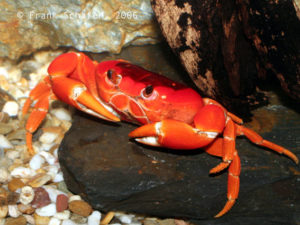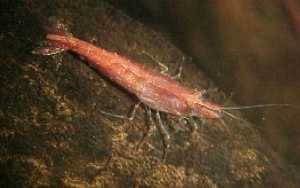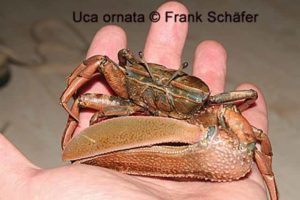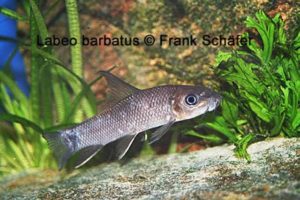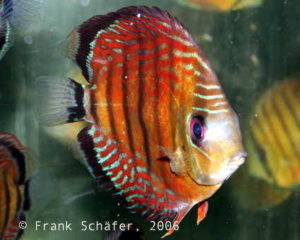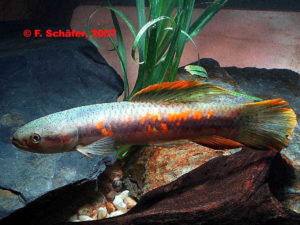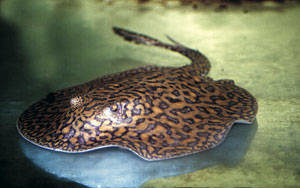Channa maculata is a snakehead which origins of the border area of China and Viet Nam. It is there very common and offered on markets in large numbers, naturally as a food fish. In their habitat C. maculata lives in ponds, lakes and ditches, usually over sandy or muddy bottoms. With a final size of […]
Fish Archive (3137)
-
-
Mastacembelus greshoffi
Some time ago we could import Mastacembelus greshoffi from the Congo. Here we have a spiny eel getting approximately 35 cm long, which occurs over rocky bottoms in rivers and lakes, also in rapids. Spiny eels are intelligent fish, they show a multiplicity of interesting behaviours. They also can become amazing tame and eat then […]
-
Brotia pagodula
(28.Nov.2007) From Southeast Asia we got a still rarely traded snail species. Brotia pagodula is a live-bearing snail, as an endemic species it can be found only in the Moei, a river between Myanmar and Thailand. Their strongly wound house, provided with numerous spikes, gives them a bizzare appearance. On the search for algae they […]
-
Procambarus clarkii „WHITE“
Under the numerous color forms of the Red Swamp Crayfish is Procambaris clarkii „White ” at present very popular. They are tough tank inhabitants, easily to reproduct and possess a high reproduction rate. Procambarus clarkii does not place large requirements towards the water chemistry, a strong filtering is however necessary, since they have a strong […]
-
Devario regina
The Queen Danio (Devario regina) is a tropical fish belonging to the minnow family (Cyprinidae). Originating in India, Myanmar, Thailand, northwestern Malaya, and the Mekong basin it is quite rarely seen in our tanks. Other species often found in the same locality as D. regina are Puntius lateristriga, Rasbora paviei, various Poropuntius, Neolissochilus, Barilius, Nemacheilus […]
-
Corydoras ephippifer
This true mailed catfish species was imported from Belem (Brazil). The latin name „ephippifer“ is a combination from „ephippium“ (lat. = saddle) und „ferre“ (lat. = bearing) referring to the black spot on the basis of the dorsal fin. The animals reach a maximal length of 6 cm. They should be kept in a group. […]
-
Diskus Nhamunda rosé
Nhamunda Rosé is the trade name of a strain of the brown discus Symphysodon aequifasciatus axelrodi originated in the Rio Nhamunda (northern influent of Amazon, west the city Alenquer). Now again some Nhamunda Rosé are available. Characteristic for this variety is the partially laminar high red part of the brown primary colour. Thus they are […]
-
New China Tetra
-
Ageneiosus vittatus
July 2002: For the first time we could import Ageneiosus vittatus from Peru. Slopehead catfish of the genus Ageneiosus are particularly noticeable by its strongly flattened head. These predators can reach an overall length of 30 cm. For the maintenance large basins are necessary. A dark bottom, some stones and bogwood should be brought in […]
-
Nannacara spec. -Sourourou-
From the Crique Sourourou in French Guyana originates this beautiful new Nannacara variant. We are pleased to be able to offer some offspring to you. According to information of an experienced Nannacara specialist their maintenance is unproblematic, even in middle hard water. The breed however succeeds only in soft and sour water according to their […]
-
Chaetostoma pearsei L 187
This Chaetostoma species is imported in regular intervals from the upper Orinoco through Puerto Ayacucho. This catfish is very difficult to differentiate from L 147 and L 188. L 188 has often described in the literature as C. nudirostre. C. pearsi lives in fast streaming mountain brooks and therefore needs in the aquarium oxygen rich […]
-
Hypancistrus spec. L 66 „King Tiger“
As one of the early imported representatives of the so-called L-number catfishes L 66 has already an unbroken popularity. At present we can offer beside wild caughts also very beautiful german breds. Such bright grounded L 66 are at least as attractive as the most „newer“ Hypancistrus species. With a final size of approx. 15 […]
-
Protopterus aethiopicus congicus
Freshly arrived: Marbled lungfishes (Protopterus aethiopicus) rank among the genuine survival artists. For respiration they are dependent on atmospheric air, if one refuses them the admission to the surface, they can drown in the water (aquarium). The air breathing allows them, however, a nearly amphibious way of life. So they are able to withstand desiccation […]
-
Osphromenus exodon
Even this fish looks like the common gourami, it is really something special & rare. As far as we know, this species was never before importet to Germany. When they have the size of about 30-40cm, they turn their lips inside out and show many small white teeths. Unfortunately this stadium is only shown in […]
-
Mastacembelus spec. „Kamerun“
This spiny eel reached us from Cameroon. The classification to a species was so far not possible for us. Since spiny eels predominantly are found on sandy to muddy bottom, they require a sand substrate in which to dig and hide. Flat rocks are also good for these fish to burrow under; just make sure […]
-
Chitala ornata, Clown Featherback
The Clown Featherback is well known to the hobby and has been imported as early as 1934 from South-East Asia. They are nocturnal fish and when they get older they become solitary. The fish tank should be decorated with dense patches of plants on the sides and back but should be kept with enough swimming […]
-
Ctenochromis polli
Ctenochromis polli occurring in the Congo River belongs to the rather rarely kept cichlids. Despite their body length of maximally 11cm they should not be kept in too small aquariums (100cm). The males are quite aggressive and pursue the females and suppressed males. They need sufficient hiding places, therefore the interior arrangement of the aquarium […]
-
Orthochromis stormsi
Orthochromis stormsi reached us as bycatch with Steatocranus casuarius. Both species originate from Central Africa, where they inhabit the cataracts of the Congo River. Their maximum size amounts to 12 cm, whereby the females remain somewhat smaller. The differences between sexes are only weakly pronounced, males appear more multicoloured, females have a darker basic colour. […]
-
Cichla temensis
Cichla temensis does not represent a fish for everyone. We could import them from Venezuela, where they are estimated fishes for consumption and sold under the name Tucunare. In its natural environment they can reach an overall length of 1 m with a weight of approximately 10 kg. They grow to be the largest of […]
-
Retroculus lapidifer
To take sensibly care of Retroculus lapidifer, which comes from Rio Tocantins/Rio Araguaia catchment area, you should own quariums with a base of 150 x 60cm minimum, as this species can grow very big (25-30cm). But despite its size you should not socialize it with aggressive cichlids, because it has only a certain self-assertion among […]
-
Cambarellus patzcuarensis
November 2003: New arrival! The orange dwarf lobster, Cambarellus patzcuarensis. They grow only up to 3-4cm. Just yesterday we got a very limited quantity from a german breeder. These dwarf lobsters are slightly agressive among each other. The origin is the lake Patzcuaro in Mexico.(Photo F. Schäfer, Text K. Diehl)
-
Sesarma spec. „Neon Face“
April 2005: These days we got a new crab species from Asia. The blue green irisdescent coloration of its face advised the name „Neon Face“. If further information is available, we will add it to our text.(Photo F. Schäfer, Text K. Diehl)
-
Devario spec. „Bloodstripe“
This danio originating from Asia grows to approx. 12 cm . Devario spec. “Bloodstripe” represents an attractive enriching of the offered danio species. The habitat of the fish, drawn with a remarkable red strip, is located on the Indian subcontinent. Females are more corpulent and somewhat larger than males according to the typical danio pattern. […]
-
Corydoras sp. C 30
Corydoras C 30, a scientifically still not described species, originates from the area of the Amazon delta (Federal State Amapa) in Brazil. In its appearance it reminds of Corydoras melanistius a further north in Surinam and Guyana occurring species. Like all Corys C 30 should be held not in a to small group (5 – […]
-
Phenacogrammus cf. nigropterus
This new African tetra, presented by Dieter Bork in “Das Aquarium” 12/01 as “pastel-congo-tetra”, comes from Lake Maindombe (also known as “Lac Leopold II”) in the Democratic Republic Congo (Zaire). Ornamental fish breeder Winter was able to multiply them in a bigger number of pieces. The fins of the males are pulled out beautifully and […]
-
Hyphessobrycon haraldschultzi (= spec. „Araguaia“)
Red fish always attract interest amongst hobbyists, especially the intensively red coloured ones. Five years ago when we received the first animals of this tetra by the name of “Hyphessobrycon serpae – the real one” (wildcaught from Rio Araguaia), we were immediately enthusiastic, too. At first sight (still inside the transport bag) these tetras looked […]
-
Nanochromis sp. „Lezas“
With Nanochromis sp. “Lezas” we can offer a further highlight of German bred fishes. As at the before introduced species this dwarf cichlid is hardly to be exceeded in colour and quality. Particularly noticeable is the strong red colouring of the dorsal – and the upper parts of the caudal fin. In dark, peat-coloured water […]
-
Yasuhikotakia sidthimunki
From northern Thailand originates the Dwarf Loach formerly known as Botia sidthimunki. Since it is a rather small (6 cm) and very peaceful species, it represents an ideal member for an asiatic community tank. There it can be kept together e.g. with small representatives of the genera Danio, Rasbora and Microrasbora . One should always […]
-
Cochliodon sp. YELLOW SEAM L 360
From the Rio Jamanxim in Brazil we could import a small number of L 360 with nice yellow-orange fins. They are unproblematic in the maintenance need however a high portion of vegetables in their food. Similar as Panaques this over 30 cm large growing species specieseats large quantities ofr bogwood. A high performance filtering unit […]
-
Hypancistrus spec. NEW
September 2006: Latterly we received this very rich contrasted male of an unknown Hypancistrus species. Certainly here exists a similarity to L 333 and also Hypancistrus spec. Xingu. It gets more and more difficult to attach single fishes to existing L numbers or to a known Hypancistrus species, because there are not enough hard criteria […]
-
Panaque cochliodon
December 2005: After years when no Panaque cochliodon (Panaque suttoni, P. suttonorum) were imported, now again few individuals reach us. Whether environmental problems or the civil war in parts of Colombia are responsible for their non appearence, can not be judged from a distance. We are glad to see this in former times not rare […]
-
Chitala ornata „Striped“
This variation of the Clown Featherback has a very marked body pattern. The breeding of C.ornata In captivity has been succeeded on several occasions. The fish spawn on the hard substrate and the eggs are guarded by the male fish, who also fawns the eggs. In nature the care of the spawn is important for […]
-
Teleogramma depressum
This rapid inhabitant from the lower Congo catchment area, which grows up to 10cm is generally regarded as the worlds flattest cichlid. At first sight it it looks like the little more known T. brichardi, but T. depressum – as the species name already tells – is distinctly more flattened, which you can especially see, […]
-
Geophagus altifrons
You can surely excellently argue about taste, but the various populations of Geophagus altifrons could justly conquer a solid place among Cichlid lovers. And one of the most beautiful variants might be Geophagus altifrons “Tapajos”. Additionally, G. altifrons is an easy-to-keep cichlid. It requires aquariums with at least 500 ltr. capacity due to its size […]
-
Camptandrium sp.
July 2006: Few days ago we could import a new attractive crab species. It belongs to the genus Camptandrium, the species is yet not determined. They originate from India, where they were caught on the banks of the Ganges river in the proximity Calcuttas. There they live in estuaries and a therefore a salt additive […]
-
Demanietta spec. Laos
From the border area of Laos and Thailand origins the expressed beautiful fresh water crab Demanietta spec. „Laos“. They exist in different colour forms. Fresh water crabs need an aquarium with a land- and water part. Some branches or stones will offer them climbing possibilities. As omnivores they despise nearly none of the usual crab-food, […]
-
Sesarmops intermedium, Flower Crab
This crab is known under the trading name “Flower Crab”. It will not outgrow 4 cm, measured by its carapace. These crustaceans have two large, red claws, which could weigh up to half the total body weight. In nature they feed mainly on algae and other organic material, which they catch with smaller pincers. The […]
-
Barbus hulstaerti
August 2006: Last night we received a small jewel from the Congo basin. For the first time a somewhat larger number, of the more than 30 years for the hobby lost Butterfly Barb Barbus hulstaerti could be imported. The lively fish, reaches 4cm in length and fascinates by its wonderful colors. In their area of […]
-
Discherodontus ashmeadi
The redtail barb Discherodontus ashmeadi originating from the tropical Southeast Asia can reach an overall length of up to 14cm. As habitat Mekong and Meklong are indicated. In their appearance the dark dorsal fin mark, as well as the strongly red markings of the caudal fin are particularly noticeable. In their habitat they inhabit brooks […]
-
Corydoras sp. C 71
August 2006: With Corydoras spec. C 71 we could import a further rare species from Brazil. They originate from the Rio Arua in the Federal State Para. With a final size of 6 cm they belong to the medium sized Corys. The requirements for their maintenance might be the same as for other Corydoras species. […]
-
Hydrolycus tatauaia
From Peru some sabre toothed Tiger Fishes of the species Hydrolycus tatauaia came to us. For the maintenance of these impressive hunters naturally roomy aquariums (> 1000l) are needed. Young specimen can be kept in swarms, in the wild even swarms of mixed species were observed. With ageing their aggression potential rises and they become […]
-
Pseudohemiodon thorectes
This catfish coming from Bolivia, belongs to the smallest of his relatives, measuring 13 cm maximum. It is mostly getting imported by travelling aquarium hobbyists. Regarding the water condition this kind is rather adaptable, as guide values of up to 400 µS/cm and a pH-value of 7.6 were measured. Approx. 25°C are quite enough for […]
-
Microsynodontis polli
Microsynodontis polli is one of three poorly documented pygmy Synodontis species, the other two being M. lamberti and M. batesii. They origin from Western to Central Africa, M. polli is reported for the upper Niger in Guinea and Liberia. Their maintenance is no problem as long as the water is soft and slightly acidic, although […]
-
Callichthys spec. NEW
From southern Brazil we could import a probably new Callichthyid catfish species. The sexes can be easily differentiated on the basis the dark pattern at the head of the females. In their homeland they inhabit diverse waters types. As accessory air-breathers they can move over land if it gets necessary to reach other waters. Their […]
-
Aplocheilichthys katangae
From the Katanga province of the Congo we recieved Aplocheilichtys katangae. These non seasonal killies have a large distribution area in the central southern Africa. There they inhabit shallow, overgrown brooks and ponds. Their maximum size is approximately 6 cm. They feed on small water insects and crustaceans in tanks they can be fed with […]
-
Botia sp. „New Emperor“
The ever first import of Botia sp. “New Emperor”, probably comes from the borderland of Burma/Thailand. It should appear in a decadal yearly rhythm in a large amount and can only be caught then. An area informed ichthyologist stated that transportation through bordering hilly regions can only be helped by small mopeds, where a slight […]
-
Hypancistrus spec. „Belo Monte“ (L 287, L 399, L 400)
The denomination of this beautiful Hypancistrus is still disputed. It run long time under the number L 287, so it is named on our stock list. Recently it is called L 399 and/or L 400, the origin is the Rio Xingu, where it gets caught in the neighbourhood of Belo Monte. This species belongs into […]
-
Notropis chrosomus
(21.Jan.2008) Rainbow Shiner, that is what they are called! We have this dream in limited numbers available. They are really easy to keep and grows up to 6cm. They do not demand special water conditions, but they should be kept in water which is rich of oxygen. Their origin is Northamerica. You can find them […]
-
Channa stewartii
This often under the name Channa cf. barca traded Snakehead originates from the Indian province Assam. C stewartii can reach a length of 30 cm and as predators they should kept together only with fishes whose length exhibits at least 2/3 of their body length. Beside living and dead fish they accept food as insects, […]
-
Cyphotilapia frontosa var. „DARK BLUE HORIZON“
March 2005:New on our list and absolutely rare: Cyphotilapia frontosa var. “DARK BLUE HORIZON”. We are proud to present these only in extremely small number existing variant of the well-known Cyphotilapia frontosa. Beside the remarkable longitudinal striation the animals are characterised by a very intensive blue. Since so far only very, very few animals are […]
-
Satanopera acuticeps
Normally the durable care of Satanopera acuticeps is only possible in soft and sour pH-value. But as it was finally successful to breed this eartheater inside the aquarium, it could be that the bred ones are easier to keep and even easier to breed. So far the breeding was possible furthermore only in soft (< […]
-
Carcinoscorpius rotundicauda
Horseshoe crabs are rightfully described as living fossils, because their ancesters populated the warm flat seas about 500 million years ago.The description of the horseshoe crab is misleading because their next relatives are arachnids and not the crabs. The Moluccan-horseshoe crab that is being presented, comes from southeast Asia and lives in coastal ranges from […]
-
Euryrhynchus amazoniensis
April 2006: Now available again: Euryrhynchus amazoniensis a rare shrimp species from South America. The delightful pattern of points and stripes on their body justifies its English name Peru Zebra Shrimp. For a long-lasting maintenance the only 3 cm large getting species needs low pH values and soft water, since otherwise a certain susceptibility against […]
-
Tanichthys albonubes „Gold“
Tanichthys albonubes “Gold” is a selection of the well-known White Cloud or White Cloud Mountain Minnow. They were imported since the end of the 30's of the past century and were called at that time “Working Man's Neon” or the “Poor Man's Neon”. This referred on the one hand to its attractive colouring, otherwise it […]
-
Diskus Royal Blue/Rio Moju
If an increase of beauty and charisma of the at 01.02.06 introduced Diskus variant Red Inferno/Rio Moju is still possible, then by the Royal Blues originating from the same river. When first seeing these fishes I remembered the headline of an old “aquarien magazin” article. In January 1972 Eduard Schmidt Focke a famous german discus […]
-
Cheirodon spec. „Gold Neon“
At present we can offer some Cardinals of the variety „Gold Neon“. This is one of some more in the wild rarely existing colour forms of Cheirodon axelrodi. Actually it is not clear whether this colour forms are distinct species or varieties of the cardinal. At the “Gold Neon” the blue colour strip is replaced […]
-
Pterosturiosoma microps
Pterosturiosoma microps is one of the regularly imported Loricariidae from Peru, although not in bigger quantities. Even though it is more impressing in colour by its soft black-grey, it can still arouse enthusiasm by its remarkable appearance and its impressive but graceful fins. But its steady nursing is not quite easy. Whereas the acclimatization probably […]
-
Synodontis angelicus
From the Katanga province of the Congo we could import some partly striped specimen of Synodontis angelicus. Formerly these forms were regarded as the subspecies Synodontis angelicus zonatus, today they are considered however as a color variant of the species. In any case they are very decorative and should not be missing in Congo basins […]
-
Chromobotia macracanthus
In our picture you see an interesting mutant of the clown loach, which reached us these days. Although Chromobotia macracanthus formerly known as Botia macracantha is a long time tank inhabitant, it is still not without mysteries. This applies particularly to the breed, so far we have only coincidence success. Also in the maintenance they […]
-
Hypancistrus zebra L 46 „Double Tailfin
November 2006: At present we can offer beside „normal “German bred zebras (surely the most demanded of all L-numbers) an individual with a doubled lower caudal fin. This change of the fin is probably to be led back on a disturbance in the embryonic development. If someone hopes to breed a race of „veil tailed […]
-
Panaque spec.
June 2006: Just freshly arrived! Also for „old stagers“ there are again and again genuine surprises with us. In a shipment from Peru we received today several particularly delicate Loricariids, which represent a petite alternative to the frequently maintained Hypancistrus species. However their size of (50 – 70 cm) probably exceeds the possibilities of most […]
-
Gnathonemus longibarbis
March 2007: From the environment of Lubumbashi, the second largest city the Congo comes Gnathonemus longibarbis to us. They were caught in close proximity to Bondaka and are probably for the first time in the trade. In nature they feed on water insects and their larvae, their final size probably lies at approx. 40cm. Since […]
-
Micropterus salmoides
Something special for your pond. The Largemouth Bass originates from the eastern part of the United States where they occur from the Canadian border down to Mexico. In the meantime they were spread in numerous countries as game fish and can therefore be found also in Europe. They prefer quiet, well warmed waters without a […]
-
Geosesarma sp. VAMPIRE
March 2006: They are among us. Fortunately only in a small number: Vampire crabs! With a close look the horror will pack you, remind the ends of its shears very strongly of the carnassial teeth of vampires. At night one would like to meet them with their shiny red eyes in no case. Now in […]
-
Barbus jae
The Jae barb is one rarely out of central Africa imported dwarf barb. With scarcely four centimeters of length they attained full growth and show an attractive red coloration on their fins. The red hue of the fins is more weakly pronounced with the females; their body exhibits predominantly beige-brown tones. In addition the females […]
-
Diskus Semi royal, Rio Moju
Like the introduced before Discus from the same area (Rio Moju) the “Semi Royal” variant shows a strong red coloration at the seam of their body and their fins. With them the wave pattern is nearly continuous distributed over the entire body. (Photo F. Schäfer, Text K. Diehl)
-
Cynopotamus atratoensis
Only three of these predatory characins found their way to Aquarium Glaser. This group of characins form the subfamily Cynopotaminae within the family of real American characins (Characidae). The representatives of this subfamily are relatively large fish, which can reach a total length between 15 and 30 cm in adulthood. Cynopotamus have large mouth openings […]
-
Rineloricaria melini
As a further german bred rarity we can offer Rineloricaria melini at present. Our specimen of the probably most attractive Rineloricaria species have with 9 – 12 cm length already attained full growth and are of outstanding quality. Their origin is the area of the Rio Negro where they live in black water biotopes. Like […]
-
Potamotrygon menchacai
September 2006: From Potamotrygon menchacai, the tiger stingray, we could import a big, very beautifully patterned, female animal with approximately 60 cm in diameter. Tiger-rays can be colored quite differently and particularly can differ in the contrast. Our tiger rays come from Peru, through size and scrutiny, they certainly are among the most impressive “ornamental-fishes.” […]
-
Cochliodon spec. var. marbled L 360a
From the drainage basin of the Tapajos arrived a new, until now not imported loricariid catfish at our facility. Body form and yellow fin seams remind strongly of L 360, the body and parts of the fins however exhibit a veining atypical for L 360. In their maintenance requirements they might probably not differ from […]
-
Glyptoperichthys joselimaianus L 1, L 22
Glyptoperichthys joselimaianus the “White Spot – Glycopterichthys” originates from the Rio Araguaia, one of the main tributaries of the Rio Tocantins in Brazil. There it inhabits different habitats, it was found e.g. on deadwood and also on flooded meadows. Natural water conditions (white water) do not have to be copied for maintenance, L 1 are […]
-
Panaque spec. „New Royal Golden Thunder“
September 2006: This week we succeeded in importing several of this beautiful new Panaque from Brazil. In their appearance they remind of L 27, are however flatter and slimmer than these. In addition they possess a larger mouth and their dorsal fin is smaller. These characteristics let assume that they originate from strongly flowing river […]
-
Awaous cf. lateristriga
From the coastal ranges of the western Africa between Senegal and Angola originates the freshwater goby Awaous lateristriga. The animal introduced here reminds strongly of this species, whether it is identical to it could yet not be determined. With an overall length of approx. 30 cm Awaous lateristriga belongs to the larger gobys. In their […]
-
Sphaerichthys osphromenoides
Sphaerichthys osphromenoides is the most famous representative of the in southeast Asia indigenous chocolate gouramis. Like other chocolate gouramis Sphaerichthys osphromenoides is a delicate and at least while settling down a sensitive fish. It’s natural biotope are shore areas of small, still and slow-moving black water on the Malayan peninsula. As a typical black water […]
-
Pelvicachromis spec. „Blue Fin“
November 2005: From Guinea the import of a still undescribed Pelvicachromis species surprised us. This species seems to mediate within the genus Pelvicachromis between P. roloffi and P. rubrolabiatus, since it carries characteristics of both species. Particularly the name giving bright blue-green dorsal fin of females is noticeable. Maintenance in pairs is appropriate, in larger […]
-
Acarichthys heckelii
January 2007: At present we can offer particularly beautiful Acarichthys heckelii from the region around Santarem. These fish are characterised by an intensive yellow colouring of the body. It forms a beautiful contrast to the red eyes and their magnificent fin rays. Acarichthys heckelii has a large area of origin along the Amazon and the […]
-
Heros severus
Despite the fact that Heros severus is the type species of the Heros genus, this species is the most uncharacteristic representative of this group. This is mainly caused by its reproducing behaviour, which is mouthbreeding and untypical for Heros, because they are all substrate breeding. Also the coloration is different from the other members of […]
-
Geosesarma sp. „orange“
March 2006: The mandarin crab, a further still undefined Geosesarma species, reached us these days from Sulawesi. It is characterised by a very intensive red-orange colouring of the legs and particularly the claws as well as bright yellow eyes. Thus it represents a beautiful coloured contrast to the last week introduced vampire crab. Whether a […]
-
Uca annulipes
May 2005: One of the most beautiful fiddler crab, Uca annulipes has been available now. Fiddler crabs, a family of 65 species, live worldwide in tropical and subtropical areas where they inhabit beaches and swamps. They reach a length of no more then 2.5 to 3 cm. The male animals have one large and often […]
-
Danio aesculapii (=Danio sp. „Pantherinus“)
These minnows originate from Burma, does not grow over 4 cm and is therefore the smallest representative of the Danio genus. But now this beautiful barb fish has been imported by Aquarium Glaser and is now available for the dedicated aquarium hobbyist. As with all representatives of the Danio family, D. sp.„Pantherinus“ is a schooling […]
-
Inlecypris auropurpureus
Inlecypris auropurpureus belongs to in Inlé lake in Myanmar occurring endemic fish species. That about 6 cm long becoming swarm fish should be held in well planted to not too small (80cm) tanks. Since they are good jumpers, young animals of 1,5cm length can already jump over 10cm high, the tanks have to be completely […]
-
Diskus „Nhamunda rosé”
Nhamunda Rosé is the trade name of a strain of the brown discus Symphysodon aequifasciatus axelrodi originated in the Rio Nhamunda (northern influent of Amazon, west the city Alenquer). Now again some Nhamunda Rosé are available. Characteristic for this variety is the partially laminar high red part of the brown primary colour. Thus they are […]
-
Pristobrycon maculipinnis
April 2006: This week we got some very nice Pristobrycon maculipinnis. This rarely traded and in the fish keeping hobby almost unknown species is characterised by intensive red colored fins, as well as a pronounced examination of black markings over the silver shining body. Maybe it is the most attractive of all Piranhas, it originates […]
-
Hisonotus notatus
July 2006 From southeast Brazil we could import some rare pieces from the relationship of the popular Otocinclus species. In its homeland Hisonotus ornatus inhabits with weeds infested waters. It may not be kept too warm. 24°C probably represents the reasonable upper limit. The requirements for their maintenance do not differ from those of the […]
-
Rineloricaria sp. „Colombia“
A remarkable species which came in in one of our import from Colombia. These fishes also originate from the Rio Chacu in the northern tip of the country. Because of the many bristles of the male this species has been falsely determined as Rineloricaria latirostris. A comparison with the pictures (see Mergus Catfish Atlas Part […]
-
Oryzias celebensis
Oryzias celebensis the Celebes rice fish originates, as the species name indicates, from Indonesia where it inhabits the island Celebes. It lives in standing to slowly flowing waters which are heavily planted. As an approximately 5 cm large becoming schooling fish it needs a free swimming area and retreat possibilities, since rice fish occasionally tend […]
-
Ancistomus sabaji L124 „Big Spot“
Ancistomus sabaji – Hypostomus spec., Peckoltia spec.? A fish with many names! There is hardly another L number catfish where the confusion regarding the nomenclature is as large as with this species. This is a result of the generous allocation of numbers (L 75, L 124, L 301 and LDA 2) for this fish. One […]
-
Hypostomus luteus
From southern Brazil and northern Argentina originates the probably most beautiful representative of the genus Hypostomus. Contrary to many other loricariids they become more beautiful with increasing age, since the portion of the yellow body parts constantly increases. Their southern area of origin suggests a tolerance in relation to low temperatures. They can be can […]
-
Panaque spec. „Papa Ojo Chico“ L 90a
With L 90a we can offer at present one of the most beautiful Panaque species. Especially the extremely long, orange colored filaments of the caudal fin are remarkable. In addition, the discrete black markings on the noble-grey colored body let them appear very elegant. With the purchase of these fishes their final size (over 30cm) […]
-
Tetraodon mbu
April 2002: Yesterday we received from the Republic of Congo, this beautiful Tetraodon mbu, the real congo-puffer. We got this item in this huge size never before.The maximum size cited in the literature is nearly 70cm. It is astounding how individuals differ in their behaviour: there are shy and also agressive ones. More details you […]
-
Eretmodus cyanostictus „Kigoma“
Eretmodus cyanostictus is among the group of cichlids called gobies. Gobies only occur naturally in the surge habitat of Lake Tanganjika, which is the upper meter of the water at the shoreline. They unique in that their swim bladder is non-functional, meaning that when they’re not swimming, they drop to the bottom like a rock. […]
-
Ceylonthelphusa kandanbyi
The leopard crab Ceylonthelphusa kandanbyi represents an attractive addition to the offered crustaceans. This 1999 scientifically described species originates from Sri Lanka where it is found in the Bentota river system. According to statement of our supplier the animals were caught in the proximity of Mathugama city a town in the western part of Sri […]
-
Gercarcinus ruricola
This splendid land crab (Halloween-Crab, Gercarcinus ruricola) occurs in two colour variants, specifically with red or white base coloration. The colour variation involves both sexes. A mixed pair lived together in harmony for several weeks in my terrarium. These creatures are essentially vegetarian, but will occasionally take frozen foods intended for aquarium fishes, eg bloodworm. […]
-
Neocaridina sp FIRE/CHERRY
July 2004: Yesterday we got a limited number of this beautiful shrimp, which belongs to the family of Neocaridina. This type was imported one year ago, but also only in small numbers. They do not demand special water parameters and can be easily fed with common fish food. They can be kept in community tanks, […]
-
Uca ornata
January 2006: For the first time in Germany: The fiddler crab Uca ornata. We are proud to introduce this new species to the pet market. We got only few animals from Ecuador, hope however for further imports of this species. Further information for the maintenance of this at the Pacific coast from Ecuador to Nicaragua […]
-
Danio choprai
From Myanmars rivers and brooks origins Danio choprai the Glowlight Danio. With a length of 4 cm they have already attained full growth. With them as with many swarm fish the effect on the observer rises with the swarm size, a group of 30 animals is always impressing. Glowlight danios are good to keep and […]
-
Labeo barbatus
As a further new import from the Congo we can present you Labeo barbatus. It is a about 60 cm growing representative of the genus Labeo, which is represented in the Congo River with at least 34 species. In its habitat it lives in sections with strongly flowing waters. About its behaviour in aquaria little […]
-
Diskus „Red Inferno/Rio Moju“
In the following pictures you see some impressions from our discus installation. Seldom could we offer a so large selection on magnificently coloured, perfectly acclimatized Discus. The animals originating from different areas are even in our facility hardly to exceed in colour splendour. Since all of them attained full growth, breeders can fast extend their […]
-
Erythrinus erythrinus
June 2007: Last week we imported from Peru a small amount of probably the most beautiful of all wolf characins. A big advantage of Erythrinus erythrinus is it’s size, that stays with about 25 cm in a tolerable area. It doesn’t have excessive claims with water-chemistry. In it’s homeland, it lives next to small streams […]
-
Potamotrygon sp. „Mantilla ray“
This freshwater ray originates from Paraguay. The multitude of forms and colours never stops to amazes one. In the past the scientific description of freshwater rays used to be done according drawings without any conserved specimens from natural museum history collections. The classifications of live animals by such limited descriptions are almost impossible to make.(Photo: […]





